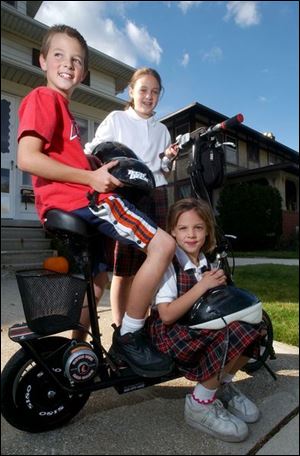
Power scooters ride a fine line with area police
10/19/2003
Zachary, Jackie, and Mackenzie Guenin, from left, are enthusiastic about the battery-powered scooter their dad bought a week ago to help them get around their South Toledo neighborhood efficiently. But police point out that it's illegal to ride the scooters on sidewalks.
They seem to be everywhere warm weather has been this year - youths riding motorized scooters on streets or sidewalks to visit friends, go to parks or ballfields, or run errands.
And their popularity, especially as a possible Christmas gift, appears to be as a bright as their metallic colors.
Richard Guenin just bought a $200 Schwinn electric model for three of his four children to use. Ten-year-old Zachary rode it from the family's Harvard Boulevard home to football practice a mile away on Sherwood Avenue for the first time Wednesday, and his friends were impressed.
“I ride it around as much as I can, but I've got to let my sisters use it too,” Zachary said.
There's just one problem. Nearly everywhere, motorized scooters are illegal to operate on sidewalks, area police officials say, and they're allowed on the street only if they're registered, insured, and equipped with an array of safety devices.
“If it's on a roadway at all, it has to be registered,” said Sgt. Robin Schmutz of the Ohio State Highway Patrol.
For that to happen, Sergeant Schmutz said, a scooter has to be titled, insured, and be outfitted with lights, a horn, a seat, and turn signals - requirements that can add hundreds of dollars to a scooter's cost.
Furthermore, Ohio operators have to have a valid driver's license with a motorcycle endorsement, which effectively rules out what has been one of the market's prime customers - teens too young to drive.
In Michigan, scooters can be operated at age 15 with a moped license, but the same safety equipment is required as in Ohio.
“If they don't possess all the required equipment, they're pretty much limited to private property,” Michigan State Police Sgt. Lance Cook said. “Because they're considered to be motor vehicles, they're not supposed to drive on the sidewalk.”
Mr. Guenin said he bought the scooter for his children as a matter of efficiency - it saves the time and fuel that would be consumed to run them around to nearby locations in the family truck.
One of the Guenin children isn't big enough to use the scooter, their father said, but the others, ages 6 to 12, know they have to wear helmets, stay on the sidewalk, avoid pedestrians, and watch out for cars if they cross any streets.
Mr. Guenin said he didn't think riding the scooter on the sidewalk was illegal. If it is illegal, he said, then the law ought to be changed.
The Guenins' scooter can go up to 15 mph - three to four times a normal walking pace. But Zachary emphasized that he and his siblings have been thoroughly instructed about being careful.
“I don't want to wreck it, so I don't do stuff like jumping off the curb,” he said.
The Consumer Product Safety Commission reports that scooters can be dangerous, especially for younger operators. The most serious injuries and a handful of deaths are generally blamed on riders failing to wear helmets.
“Any time you're on wheels, basically, a helmet is going to be your best protection,” Mark Ross, commission spokesman, said.
About 5,900 scooter riders were injured seriously enough to go to hospital emergency rooms last year, Mr. Ross said. No figures on fatalities are available, he said, because those statistics are based on exact reports, rather than samplings, and take longer to compile.
Representatives of Toledo-area hospitals said so far there has been no discernible surge in scooter injuries here, but police in Toledo and several suburbs said they have received moderate numbers of complaints about scooter operators running on sidewalks and disregarding traffic signals.
“I've had a lot of people call about them running up and down the sidewalk,” said Sgt. Paul Kerschbaum of the Toledo police traffic section. Sergeant Kerschbaum said scooters seem to fall into a regulatory gap between toys and motor vehicles.
Sergeants Cook and Schmutz said they've heard more complaints from parents who've bought scooters for their children, only to have the children stopped by police.
“They'll say, `I paid $600 for this thing, and now you're telling me we can't use it?'” Sergeant Cook said.
“There seems to be a lot of misleading information getting to buyers from dealers,” Sergeant Schmutz said.
Rod Kirian, owner of BG Motorcycles & Accessories in Bowling Green, said he makes sure his scooter customers sign safety releases, as required by manufacturer Go-Ped. The releases include, among other things, pledges to use helmets and elbow and knee pads, and to stay off public streets.
Mr. Kirian estimated that two-thirds of his sales go to boaters who use scooters to shuttle between their cars and docked boats. But others go to children, or parents of children, who have seen their friends riding a scooter and want one too. Go-Ped gasoline-powered scooter prices range from $500 to $700, Mr. Kirian said, with the high-end models capable of 20-mph speeds.
“They're for off-road use only, and I stress that,” he said. “But once they get them home, there's not much I can do to control what they do with them.”